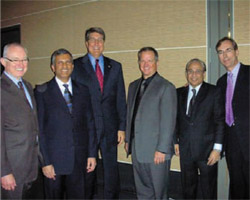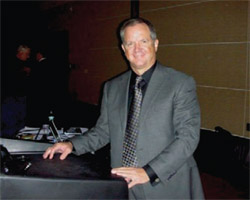Occlusion Summit Honors Dr. Lloyd Miller
The Occlusion Summit at the Yankee Dental Congress 33 gathered luminaries in the fields of occlusion and cran-iofacial research. Representatives of the Dawson Center for Advanced Dental Study, the Las Vegas Institute, Tufts University Craniofacial Pain Center, and the Seattle Institute for Advanced Dental Education participated, presenting lectures and engaging in nearly two hours of question-and-answer interaction with the audience. Throughout, the spirit of the seminar avoided the controversy that sometimes dogs the different schools of thought in this discipline in favor of an environment of collegial education—a milieu most fitting, given that the summit was held in honor of Lloyd Miller, DMD.
Dr. Miller’s 37-year career earned him an international reputation for excellence and innovation in the field of prosthodontics. In addition to his thriving prosthodontics practice in Weston, he also headed the Gnathos Dental Laboratory, which conducts research in ceramic and metal processes. He developed the Gnathos Dental Color System, which enables dental technicians to achieve truer shadings and colorations than were previously possible. A much sought-after lecturer who presented courses and seminars throughout the world, Dr. Miller was also president of the American Academy of Dental Science, the American Academy of Crown-and-Bridge Prosthodontics, the Northeast Prosthodontic Society, and the American Academy of Esthetic Dentistry.
A member of the faculty of the Tufts School of Dental Medicine since 1958, he established the Dr. Lloyd L. Miller Postgraduate Prosthodontics Student Fellowship in 1987, and in 1996 the Dr. Lloyd L. Miller Postgraduate Prosthodontics Clinic was dedicated. Dr. Miller passed away in November 2007. He is remembered by his peers for a lifetime of achievement in prosthodontics and his contributions as a clinician, but above all for his commitment to education.
Robert Chapman, DMD, chair of prosthodontics at Tufts University School of Dental Medicine and co-chair of the Summit, touched upon this in his convocational remarks, relating a conversation with Dr. Miller’s wife, who told him: "‘Lloyd loved his peers in dentistry. He believed in an endless conversation among dentists about how to do dentistry better for the health of the patients. If he were with you today, he would ask that you all take care of each other and take care of the profession—the practice of dentistry rather than the business of dentistry—and that you be honest and act with integrity.’
"It is not the purpose of this summit to create dissention, but to listen to what our colleagues have to say, why they are saying it, and to understand why there may or may not be some differences," Dr. Chapman continued. "Lloyd liked the idea of this summit because occlusion is really the basis of all we do. He undoubtedly would have had questions and comments for our speakers, so we could all learn more. We will have to do our best to stimulate our panel of colleagues in the same collegial manner that Lloyd would have done. He was a great man and a good friend to so many of us, and we will all miss him."
Gerard Kugel, DMD, associate dean of research at Tufts University School of Dental Medicine, and co-chair of the Summit, echoed Dr. Chapman. "Lloyd was an influence on most of us in this room. I remember when I was a young dentist, Lloyd was so kind to me, taking the time to talk to me and give advice about occlusion and prosthetics. He didn’t need to do that, but that’s the way he was, and I use him as a model when I work with young people today, and I think we should all be doing that."
Dr. Kugel then introduced the panelists, who were each given 20 minutes to address the audience. The first speaker was Glenn DuPont, DDS, an instructor at the Dawson Center. Dr. DuPont was followed by Noshir Mehta, DDS, director of the Tufts University Craniofacial Pain Center. Sam Kherani, DDS, a clinical director at the Las Vegas Institute, spoke third, and Frank Spear, DDS, founder and director of the Seattle Institute, rounded out the presentations.
Dr. Dupont, who approaches occlusion from a perspective of centric relation based on joint positioning in stable, harmonious function with the neuromuscular system, suggested that the field is about 90% in agreement on occlusion. "I decided what I would emphasize are the points of difference," he said, going on to discuss the importance of joint condition and position, how the teeth touch in closure, and how the teeth touch in function. "Occlusion is the most stable with the joints in centric relation as a starting point, with stable holding contacts on all teeth and anterior guidance in harmony with the envelope of function and the muscles of the functional matrix. It’s not only the way the teeth work, it’s where the lips and the tongue create pressure, too," he noted.
Dr. Mehta followed with a look at occlusion from what he termed "the other side"—patients who have some form of craniofacial pain. "When you look at it from that end, you see things that may not be so evident to you as a dentist the first time you see this patient. Having considered occlusion over the years, he said, "I have come to the think that maybe the teeth are as important as we make them out to be. But maybe the teeth are not the only point of importance in the development of dental occlusion. Functional occlusion requires muscles, joints, and teeth working in concert with the peripheral and central nervous system." Working out of a "3-D model" wherein vertical, horizontal, and lateral movements interrelate to affect occlusion, he discussed the importance of eliminating interferences and taking into account functional and parafunctional elements such as bruxism, which is known to have neuromuscular involvement in the head and neck. "If you intervene in the treatment of bruxism without affecting the bruxistic behavior itself, what you’re doing essentially is giving the person an aspirin, because you’re not treating the cause of the breakdown, you’re treating the breakdown," he said. In a nod to oral-systemic relations, he illuminated the ways in which occlusal dysfunction affects patients in areas other than their teeth, such as headaches, neck, and shoulder pain—and vice versa. "Please don’t look at the neck as a separate part of the body," he said. "It’s part of what you’re doing in the mouth. In fact, if somebody has a stiff neck, please don’t ever adjust their bite that day."
Dr. Kherani, also an advocate of the importance of neuromuscular elements in occlusion, said, "the entire aspect of occlusion that has made the most sense to me is to rely on the physiology of the human being. We have to keep in mind that occlusion is affected by a triad of points: teeth, muscles, and the temporomandibular joints, and at the same time moderated by the central nervous system. The question always is: how much attention do we pay to all of those different aspects? Do we just get subjective input about muscles, or do we measure muscular events?"
He added, "You can’t just zero in on one aspect. I don’t think form, for example, is everything. It’s a guideline, but it’s not everything. The primary organ we have to consider here is composed of muscle tissue, and muscle tissue gives rise to events because of physiology. It is the physiology that determines the end result so that we have harmony or homeostasis within the system."
Speaking last, Dr. Spear, said, "My first occlusal concept is: there is a whole bunch of concepts that work. I think the key, from a practical point of view, is to figure out in which patient won’t something work." Discussing his occlusal thought process, he continued: "My first step is the same as everyone else’s here—you do an examination of the patient and you determine whether you think the occlusion is physiologic or pathologic. If you determine that it’s physiologic, you don’t find anything wrong with the joints or muscles and you think the teeth have an acceptable level of wear for the age, there will be another couple of questions you have to ask." Chief among them is: "If you decide the patient’s occlusion is physiologic and you have to do some dentistry on them, are you going to change that occlusion?" he said, reminding the audience to bear in mind that even doing a single crown can change occlusion. "That being the case, it becomes a question not of if you will change the occlusion, but where will you change it."
Turning to pathologic occlusion, he said the question is: "How will you change the occlusion to make it work?" He discussed using the four mandibular positions, centric relation vs non-centric relation, and paying careful attention to the history of each patient in determining an appropriate treatment goal. "Learn to evaluate the signs and symptoms of a pathology in each mandibular position and learn what options you have to treat the pathology in each position, and sometimes you might even be able to make occlusion fun again," he concluded.
Throughout their presentations, all four speakers never lost sight of the fact that the summit was honoring Dr. Miller. Their clinical comments and insights, often profound, were leavened with anecdotes and remembrances of the man who had been a peer and a friend, an instructor and an inspiration to them all.
Following Dr. Spear’s talk, a roundtable commenced, bringing the audience into direct involvement in the proceedings. Questions were submitted to the co-chairs or addressed directly to the panel from floor microphones. The degree of participation, which carried the roundtable beyond its scheduled 90 minutes, reflected the complexity of the topic and the stimulating presentations by the panel, prompting Dr. Kugel to remark, "It seems to me that at the end we’re all looking for the same result, even if we get there in different ways. To have a group like this willing to spend this much time answering questions is unheard of." Though the questions were varied, most of them extended the discussion of vertical dimension, condylar positioning, technology integration, instrumentation, reproducibility of results, stability, and treatment variables introduced during the presentations.
The possibility of developing a consensus on how to treat patients was raised toward the end of the session. Dr. Mehta opined, "We are more in consensus than not. I don’t think that the differences in what we are talking about are so great that they really make a difference. It’s really a question of the patient’s needs. If you have decided what the patient needs and your decision is correct then your treatment will be correct. If your decision is not correct, I don’t care what treatment you use, it’s going to be wrong."
Dr. Spear echoed: "Lloyd wanted to do things efficiently, he wanted to do things the right way, and he also had a strong message: the best treatment is always the one that’s in the best interest of the patient, and that would be his overriding message today—if there are multiple philosophies of occlusion, ask which one is in the best interest of the patient relative to a number of variables."
There was consensus on that point—and Dr. Miller would have been proud.
 |  | |
| The participants in the Occlusion Summit. From left to right: Dr. Chapman, Dr. Kherani, Dr. DuPont, Dr. Spear, Dr. Mehta, and Dr. Kugel. | Dr. Spear at the podium. |
Lecturers and Roundtable Participants
Robert Chapman, DMD
Chair, Department of Prosthodontics
Tufts University School of Dental Medicine
Summit Co-Chair
Gerard Kugel, DMD
Associate Dean for Research
Tufts University School of Dental Medicine
Summit Co-Chair
Glenn DuPont, DDS
Instructor
Dawson Center for Advanced Dental Study
Lecturer
Noshir Mehta, DMD
Director
Tufts University Craniofacial Pain Center
Lecturer
Sam Kherani, DDS
Senior Clinical Instructor
The Las Vegas Institute
Lecturer
Frank Spear, DDS
Founder and Director
The Seattle Institute for Advanced
Dental Education
Lecturer



